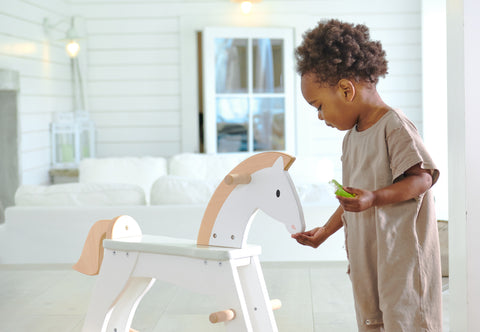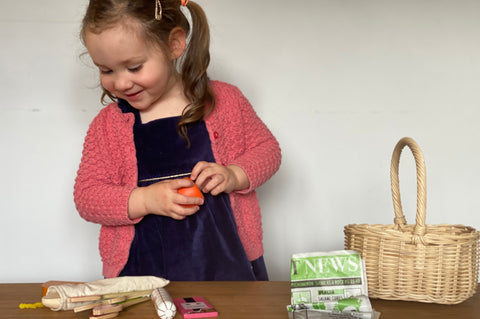How to choose the right toy | Toddlers
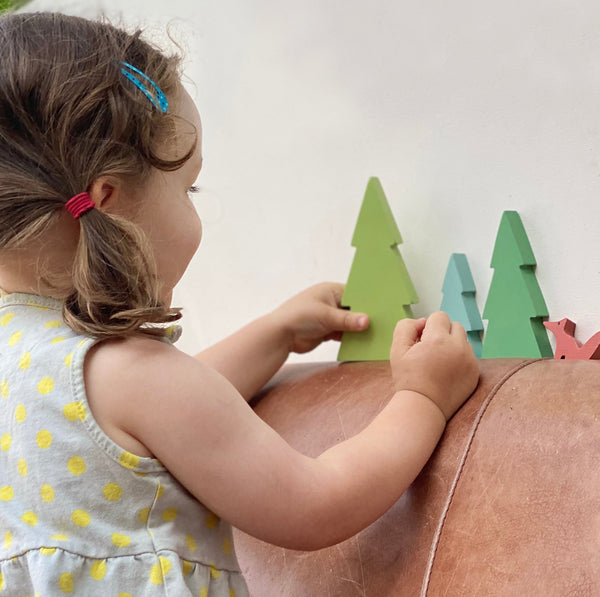
Selecting the perfect toy for a toddler might seem straightforward at first glance.
Venture into any toy store, and you're likely to be bombarded with an array of toys that vie for attention with their cacophony of sounds, a spectrum of bright colors, blinking lights, and automated movements. These items often promise instant attraction and seem like guaranteed winners—at least momentarily.
Yet, more often than not, these toys quickly end up abandoned in the playroom's corners, overshadowed by the enduring appeal of the cardboard box they arrived in.
But why does this happen?
The truth is, finding the right toy for a toddler is quite the puzzle.
Around the holiday season, the question often arises, “What would he enjoy for Christmas?” When my oldest was two, friends and family assumed he'd appreciate anything related to Thomas the Tank Engine, given his affection for trains.
Sure, he adored his train set, but the branding was irrelevant to him. His playtime was an exploration of spatial relationships and movements—concepts such as inside, outside, through, and around. These aren't mere child's play; they're the foundational bricks for the complex cognitive building known as schemas, which are critical to a toddler's development.
Understanding the importance of play
Play is not just an activity for your child; it's a fundamental part of her learning and development. Through play, your child discovers the world, learns social skills, and develops cognitive and physical abilities.

How to choose the right toy
- Developmentally appropriate. Toys should be in line with your child's developmental stage, offering a challenge but not causing frustration.
- Encourages exploration. Toys with different textures, colors, and sounds will stimulate your child's senses and encourage discovery.
- Fosters problem-solving skills. Encourage cognitive development with toys that challenge your child's mind, like puzzles and shape sorters.
- Promotes physical development. Toys that require movement aid in the development of motor skills and coordination.
- Sparks imagination. Dolls, action figures, and dress-up clothes can help your child develop language skills and learn to create stories and scenarios.
The best toys for toddlers
When it comes to picking out toys for toddlers, the key lies in selecting items that support heuristic play—this is a fancy term for play that allows children to explore and learn about the properties and functions of different materials through hands-on investigation.
Consider the toddler who rolls a ball across the floor: What mysteries does he unravel about motion and gravity? Or the child who sends a toy car vanishing behind the sofa, only to delight in its reappearance: What does she learn about object permanence?
And what of the toddler who taps on a doll's house with a toy hammer, curious about its resilience? These are all moments of learning and discovery.
As toddlers grow, their play evolves into something more complex—symbolic play. Suddenly, everyday items transform into elements of a fantastical world: a sink becomes a vast lake, a toothbrush morphs into a daring protagonist, and a blob of toothpaste might as well be a lurking crocodile.
This guide is curated to help you navigate through this transformative journey from simple exploration to the zenith of a preschooler's play: the realm of boundless imagination.
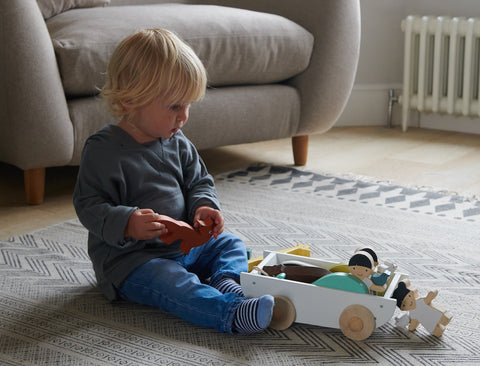
Understanding the Value of Open-Ended Toys
Open-ended toys are essentially a canvas for creativity. How many ways can one interact with a puzzle? Typically, the play is fairly prescriptive: piece together the image and the activity is complete. However, if we consider wooden blocks, the possibilities become nearly limitless. Yes, they might form the traditional towers, but they can also create elaborate castles, intricate tunnels, or become the imagined food in a play kitchen, or even pretend explosives in an adventure game. Open-ended toys defy a single purpose; they are the tools of invention in a child's hands.
With the understanding that children progress from physically manipulating objects to mentally conceptualizing them, it's clear that toys which facilitate this cognitive development are invaluable.
Below is a curated selection of the finest open-ended toys for toddlers, designed to enrich this critical stage of growth:
- Wooden animals
- Wooden blocks
- Nesting toys
- Toy vehicles
- Stacking toys
- Puzzles
- Walkers and ride-on toys
- Baskets and bags for collecting and transporting
The toddler years, though brief—spanning just from 12 to 36 months—encompass a significant spectrum of developmental milestones.
Now, let's delve into a more age-specific guide to toys, tailored to support each stage within the toddler years.

Toys for 18 months+
The simple pleasure derived from hammering games in the toddler years goes beyond the joy of making noise; it's a key developmental milestone. Engaging in these activities, toddlers are not merely striking aimlessly but rather honing vital motor skills. The act of hammering involves a controlled up-and-down motion that requires a keen sense of timing and hand-eye coordination. This repetitive action is critical as it lays the groundwork for more refined movements such as those needed for writing, where the precise control for drawing lines and forming letters becomes essential. It's through these playful hammering moments that the foundational skills for future academic tasks like handwriting begin to take shape.
See the Woodpecker Hammering Game.
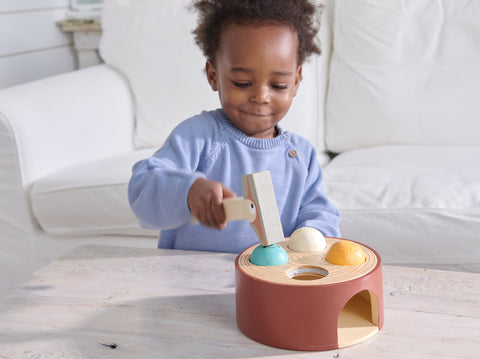
Wooden animals and arks
Wooden animal figures provide a bridge from basic sensory exploration to the rich world of imaginative play. For children around the age of two, these simple toys become the actors in a drama of their own creation, symbolizing the vast array of creatures from different habitats and times. A wooden tiger is no longer just a piece of timber; in the mind of a toddler, it roars through the jungle or paces in its zoo enclosure, crafted from a cardboard box.
For younger toddlers, the allure of these wooden animals is more tactile and straightforward. It's about the joy of placement and movement: in and out, in front, and behind. The animals are tangible companions, ideal for little hands to carry, drop into slots, and fish out again.
It's this dual nature that makes a shape-sorter ark so captivating. It satisfies the urge to fit and sort while also unlocking the narrative potential of the animals themselves. A shape-sorter ark isn't just a vessel; it's a floating stage, ready for stories of rescue and adventure on the high seas.

Wooden blocks
For the littlest architects, a first set of wooden blocks offers a canvas for developing fine motor skills. With no need for elaborate shapes or sizes, young toddlers revel in the challenge and delight of a simple stack. The act of aligning and balancing just two or three blocks can become a captivating task, laying the groundwork for more complex structures in the future.
Discover the joys of foundational play with our range of wooden blocks.
Baskets and trolleys
For toddlers, the concept of transportation is fascinating and forms a significant part of their play, reflecting their learning about movement and space. Objects that aid in carrying—like baskets, trolleys, or even their own pockets—fulfill their instinctual drive to transport items from one place to another.
This play schema not only applies to objects but extends to their own movement as well. Delight is found in the simplest back-and-forth motions, whether it's being pushed in a wheelbarrow or pulled along on a scooter. Toys that facilitate this kind of movement will resonate well with the adventurous spirit of a toddler.
Walkers and ride-ons
The initial adventure of walking is exhilarating for toddlers, but having a little assistance can be comforting. Walkers provide this support, enabling safe exploration and the joy of mobility, all while carrying a cargo of cherished toys.
For those toddlers growing in confidence, the transition to ride-ons, prams or even a rocking horse adds to the fun.
Stacking toys
As toddlers graduate from whole-body movements, their play shifts towards fine motor skills and precision. Stacking rings present the perfect challenge for these young learners. At one year old, simply placing a ring on a post is a test of skill. As they grow, mastering the order and orientation of the rings becomes their next achievement, honing their dexterity and problem-solving abilities.
- Animal stackers
- Birds
- Garden animals
- Forest creatures
- Sea creatures
Toys for 2-year-olds
By their second year, children combine newfound mobility and speech with their understanding of materials. This is when imaginative play blossoms. A simple peg doll transforms from a mere object to a character with a role—a bus driver, a shopping parent, or an adventurous child. Toys at this stage should remain uncomplicated yet versatile, facilitating the sophistication of their play narratives and interactions. The key is to provide tools that inspire their expanding imagination and allow them to experiment with roles and stories.
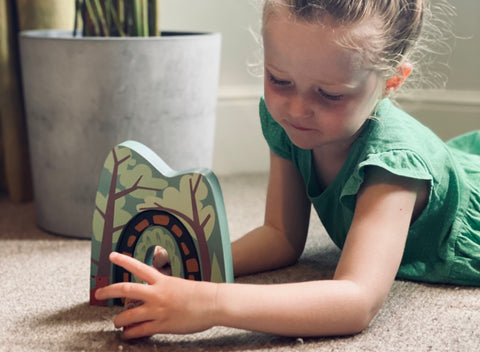
Nested toys
Nested toys, like the vibrant rainbow stackers, inherently teach sequencing. They show toddlers that objects must be arranged in a specific order, based on size, to correctly fit together. Mistakes are evident when pieces are misplaced—prompting children to self-correct. This introduces them to the concept of seriation, a precursor to understanding numerical order where three can't precede two. Through this intuitive play, toddlers begin to grasp the basics of counting without the need for direct instruction. It's play that educates effortlessly, leading to moments of triumph as they master the arrangement from smallest to largest.
Recommendations for nested toys:
Puzzles
Despite a seeming contradiction with open-ended play, puzzles are invaluable for developing spatial reasoning—a skill critical for later literacy and numeracy. Puzzles challenge toddlers to discern shapes and orientations, laying the foundation for recognizing the subtle differences between letters and numbers. While babies might attempt to force pieces into place, toddlers engage in a mental dance of turning and flipping pieces, both physically and in their imagination, to determine the correct fit before committing. This mental manipulation is a stealthy exercise in cognitive development, teaching them to anticipate and solve problems without trial and error.
Discover the benefits of puzzles for spatial development.
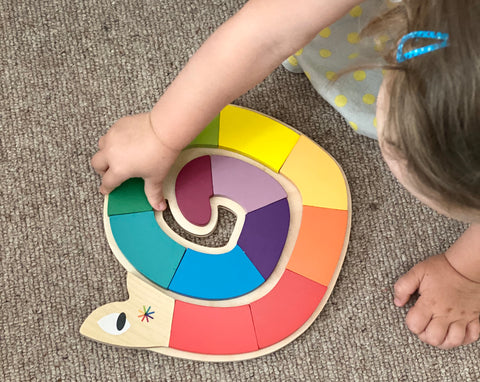
Vehicles
Toddlers' fascination with vehicles goes beyond the simple joy of movement; it taps into their innate drive to understand their environment. Vehicles embody fundamental concepts crucial for cognitive development: trajectory, oscillation, boundary navigation, and circumnavigation. As children vroom and zoom, they're not just playing—they're rigorously examining these concepts, which are vital for later learning stages. So, when a toddler is engrossed in vehicle play, they are embarking on a journey of discovery, mastering the principles that underpin complex thought processes. This makes vehicle play as enriching as it is entertaining.
See wooden vehicles.

Final word
The key to selecting the best toys for toddlers lies in choosing items that sustain playtime intrigue. While flashy gadgets may initially catch their eye, lasting engagement is fostered by open-ended toys that adapt to their evolving play styles. These toys not only grow with your child but also enhance the depth and richness of their play experiences. With open-ended toys, each developmental milestone becomes a new adventure, ensuring that the toy's allure and the joy it brings grows as your child does.

Final thoughts
Choosing the right toys for your child is an investment in her development. The best toys are those that match her evolving developmental needs and spark her imagination. They can transform playtime into a time of growth, discovery, and joy.

